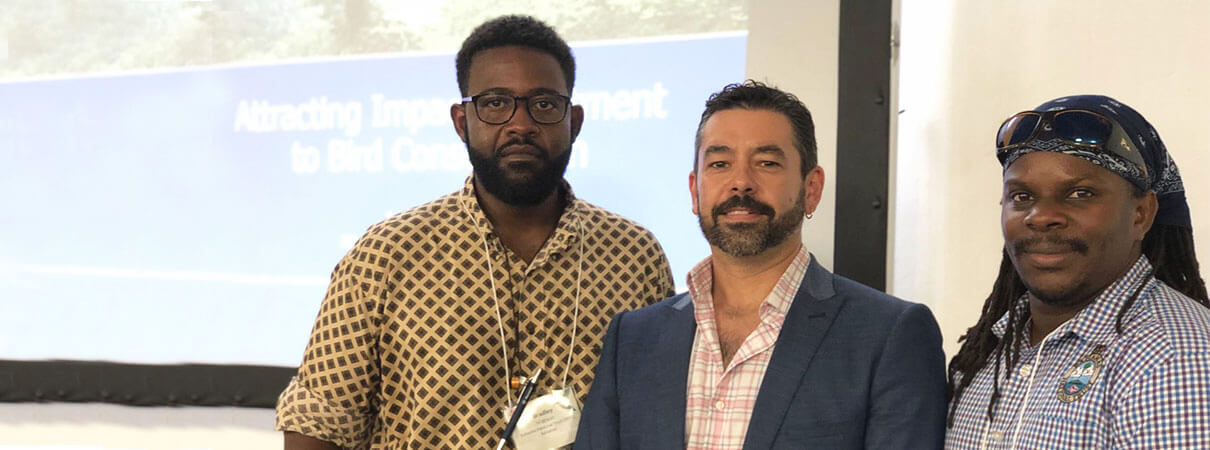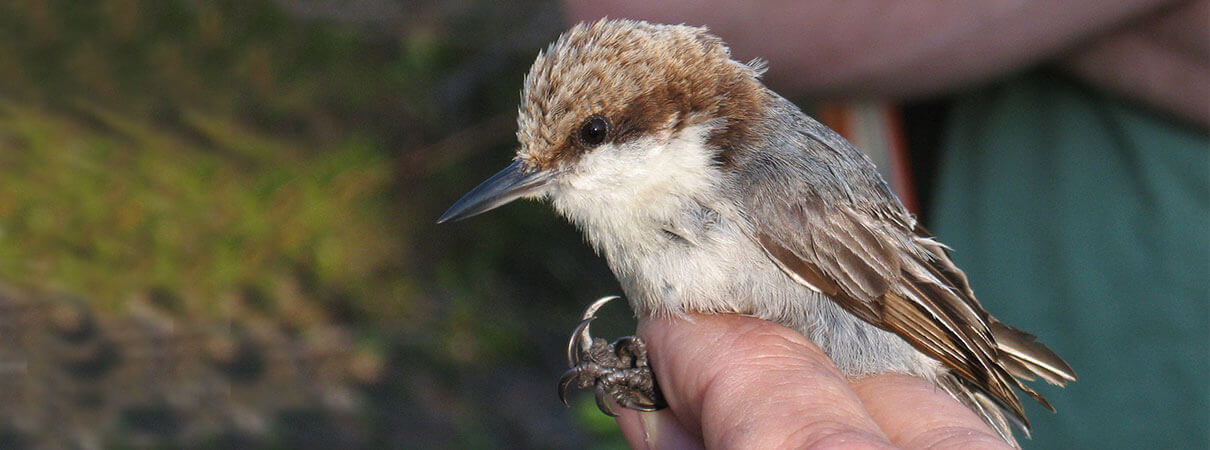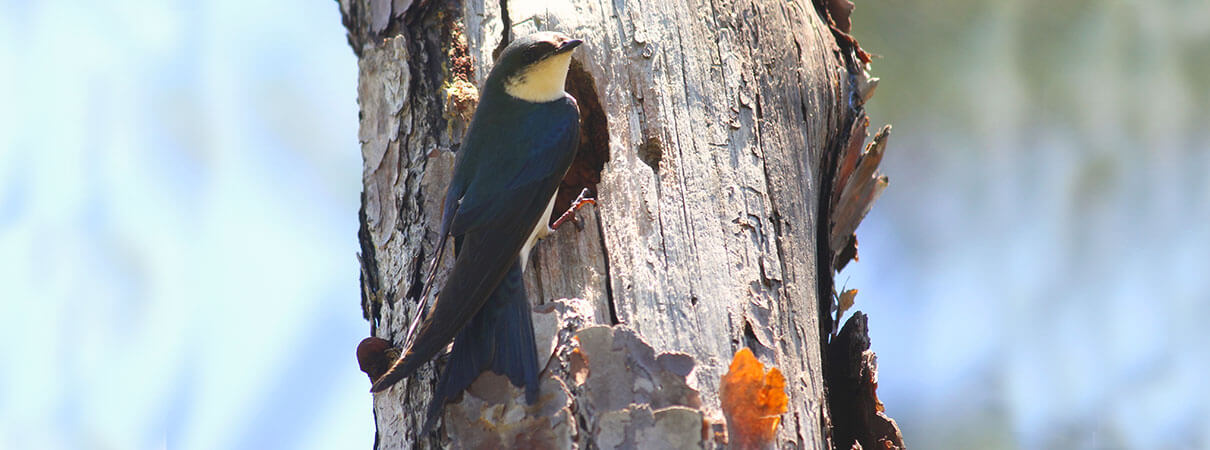After Dorian: How Are Birds in the Bahamas Doing?
In the first days of September, Hurricane Dorian roared over the northwestern Bahamas, ripping across and swamping Abaco and Grand Bahama. This colossal storm left more than 50 dead, 1,300 missing, and thousands without food and shelter. The storm also dramatically transformed the landscape.
We asked Bradley Watson, with American Bird Conservancy's (ABC's) partner organization Bahamas National Trust (BNT), for his insight on how the islands and people are doing. We also asked how birds in the Bahamas are faring.

Left to right: Bradley Watson of BNT, Andrew Rothman of ABC, and Scott Johnson of BNT. Photo by Leo Douglas
What do we know about damage, generally to the Bahamas and specifically to Bahamas National Trust, so far?
Fortunately, all BNT staff are safe and accounted for. (So are collaborators, including Zeko McKenzie of the University of The Bahamas-North, whom ABC worked with to search for the Bahama Nuthatch. McKenzie was on Grand Bahama during the hurricane.)
Abaco's residents have all been advised to leave if they are able to do so. It will take some time to return order to the island — to rebuild homes, infrastructure, and the local economy. For conservation assets, the storm left a mixed bag of bad and potentially promising news:
- At Lucayan National Park on Grand Bahama, BNT's pavilion is gone, but the boardwalk is mostly intact. The stairs into caves are intact. However, a coastline trail is underwater and may be permanently inaccessible. This trail went to an important beach for tourists and waterbirds (Wilson's Plover, Reddish Egret). Unfortunately, the Rand Nature Center was also damaged.
- On Abaco, it is possible that the national park located in the south escaped the worst damage seen in the north of the island. We are awaiting a damage assessment before we can know the full details.
Although BNT is not yet fundraising, we can receive immediate help from money raised by ABC and other partners.
What are the biggest concerns for bird conservation on Abaco and Grand Bahama following Dorian?
We need to start assessments and monitoring the birds of the Bahamas as soon as feasible to understand the species' population and habitat status changes. Here are some of the species BNT, ABC, and other partners are focusing on.
Bahama Nuthatch (Critically Endangered)

Bahama Nuthatch. Photo by Tom Benson
This recently rediscovered species only occurs on Grand Bahama. In the Lucayan Estates, where a few were found in 2018, pine trees are still standing, but storm surges brought saltwater intrusion. It could be some time before trees die from this, so we don't yet know the extent of habitat damage.
Now would be a good time to search for nuthatches in remaining habitat. This is something that we hope to do very soon.
Bahama Oriole (Critically Endangered)
It appears that Andros, where the Bahama Oriole lives, was spared the worst of this storm. Habitat there seems to be alright.
Kirtland's Warbler (soon to be delisted from the U.S. endangered species list)
These birds have not yet arrived on the wintering grounds and were likely unharmed by the storm directly. Kirtland's Warbler also often benefits from early succession habitat that develops following storms, but saltwater intrusion from the storm surge could be a problem for the habitat. In the short run, it isn't clear what the effects of this storm are.
Most Kirtland's Warblers winter on other islands less damaged by Dorian, such as Eleuthera. However, stopover sites, both in the Bahamas and in the United States, could have been affected.
Bahama Swallow (Endangered)

Bahama Swallow. Photo by Melanie Rose Wells
This is another species found only in the Bahamas. We at BNT have access to pre-storm data on Bahama Swallows from both Abaco and Grand Bahama. Follow-up monitoring will be important for this species.
“Abaco" Parrot, the Abaco subspecies of the Cuban Parrot (Near Threatened)

Cuban Parrot (Abaco subspecies has a whiter face). Photo by Natalia Kuzmina/Shutterstock
Most of the birds are in the south of Abaco, which might have been spared the worst effects of the storm. Among the dangers: feral cats and, in the short term, loss of food supplies and nest sites. (This parrot nests on the ground in the Bahamas.) Another concern is if the storm disturbance allows more invasive plants like bracken fern to spread, or if there is further damage caused by saltwater intruding into the parrot's breeding habitat.
Bahama Warbler (Near Threatened)
It's too soon to know how this species fared. We need to conduct surveys.
Bahama and Inagua Hummingbirds (Least Concern)
The Inagua Hummingbird is probably fine, as it was far to the south of the hurricane. Otherwise, hummingbirds are vulnerable to short-term losses of food supplies in storms. But plants are already re-flowering. In addition to Bahama Hummingbirds on the affected islands, there are also Cuban Emeralds on Grand Bahama.
Bahama Yellowthroat (Least Concern)
Good numbers of this warbler have previously been found on the keys off Grand Bahama. Hopefully there will be monitoring soon. Grand Bahama already has some operational hotels and vehicles. Surveys of the smaller islands off Grand Bahama are also needed.
Olive-capped Warbler (Least Concern)
This species occurs on both Grand Bahama and Abaco, but there is no current information on how they fared. We need to conduct surveys in pine forest and on the keys east of Grand Bahama.
Tell us more about what Bahamas National Trust does, and about what you do.
I have worked at BNT for six months now, in a position funded by ABC to focus on monitoring the Kirtland's Warbler on its Bahamian wintering grounds.
BNT overall manages 32 national parks in the Bahamas, including many associated with the marine environment. Three national parks are on Grand Bahama. A big part of BNT's work relates to education and outreach, gaining public support for these parks, as well as developing in-park tourist attractions. These parks are important for the Bahamian economy, as well as its endemic species and other wildlife.
How can people support Bahamas National Trust in this crisis?
ABC set up a donate page for BNT that could help with emergency operations, as well as with bird surveys and other actions needed to help birds, to repair infrastructure, etc. Getting the parks up and running will also be important for the Bahamian economy. Where possible, bird surveys searching for the Bahama Nuthatch, “Abaco” Parrot, and other species might begin within the next few weeks.


















































